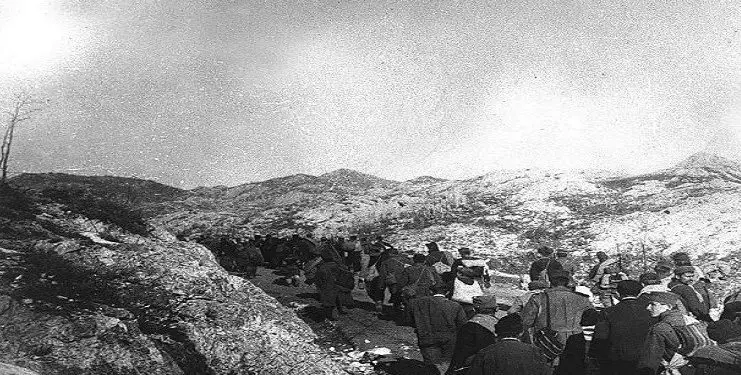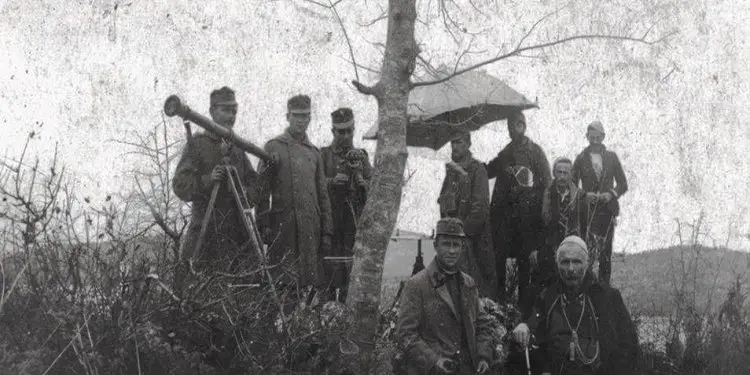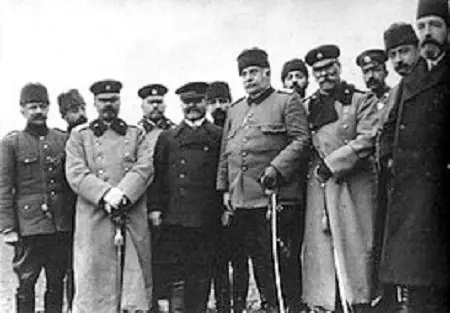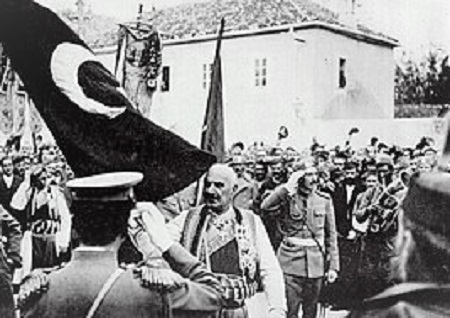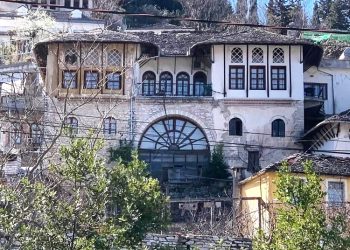From Bashkim Trenova
The tenth part
ALBANIANS ACCORDING TO THE SERBS
(THE EASTERN CRISIS AND THE BALKAN WARS)
Memorie.al / “Serbs are descended from the Slavs, a large number of tribes who gave life to the Slavic peoples. Knowledge about the origins of the history of the Slavs is modest and not so clear. Their name appears for the first time in the 6th century AD, when Byzantine writers start talking about the Slavs….”! (Dushan Bataković, Milan St. Protic, Nikola Samardžić, Aleksandër Fotic. History of the Serbian People. L’Age d’Homme. Lausanne. 2005. Pg. 3.)
Continues from last issue
INSTEAD OF THE PROLOGUE – A PROJECT, TWO MEMORANDA AND AN ANALYSIS
The Project or Nacertania of Ilia Garasanin – politician, prime minister of Serbia during the years 1852-1853 and 1861-1886:
MYTH-MYSTICISM, VICTIMOMANIA, RACISM AND SERBONOSTALGIA
Abdylhamit II (1876-1909), ordered a military action, which brutally destroyed the Albanian movement, social stagnation and political turmoil led to an anarchy that reigned almost without interruption, throughout the last century of Ottoman rule; here, Christians, mainly Serbs, were the main victims of Muslim political discrimination in Kosovo and Metohija, while Albanians were mainly their persecutors. Moreover, before any legality, the Albanian nationalism of the time, emerging from tribal roots, gave primacy to tribalism. Although stripped of ethnic terms, the Albanian national movement was still ruled by a Muslim majority and burdened by conservative Islamic traditions. Like other backward nations, in the face of neighboring nationalisms, Albanians sought help from abroad and took radical actions.
The true nature of the Albanian League and its attitude towards other ethnic communities is described in detail by Bogoslav Stavriç, dean of the Serbian Theological School in Prizren, in a confidential report sent to the Serbian government in Belgrade. In this important testimony on the Albanian League he reports that the Albanians were determined “to drive the Serbs and Montenegrins towards the old borders…and if they returned, to put these traitors to the sword. (2)
****
Ilija Petrović – historian and publicist:
Twenty years after Marko Miljanov, the ethnographer Andrija Jovičevič (1870-1939) wrote extensively about the Highlanders, first saying that Serbs, without a doubt, once lived in the Highlands. This is evidenced by many churches and cemeteries of the Orthodox type, as well as many Serbian names, which have remained to this day. “At the time of the Serbian penetration in the north of Arbania, these areas were densely populated with Serbs”. He proves this by mentioning that in Balez, near Koplik, there was a Catholic bishop, who in 1356 complained to the archbishop of Tivar that “his diocese is full of schismatics”. (Andrija Jovicevic, Malesija, Podgorica 1997).
1- Dushan T. Batakovic. Let drama du Kosovo en Serbia. A historical perspective. (The drama of Kosovo in Serbia. A historical perspective). Belgrade: Čigoja štampa, 2012. Pp. 60-63.
2 – Right there. Pg. 81.
21). “Initially, Jovicević says that the highlanders, even though they are Catholics, celebrate baptism in the same way as the Serbs. Saint Nicholas is the glory of the baptism of many Montenegrin tribes, so it can remind the highlanders of their kinship with the Serbs, for this reason, Catholic priests have tried for the Highlanders to abandon the glory of Saint Nicholas and pass it on to purely Catholic saints and feasts.” (A. Jovicevic, Cited work, 125).
“The Highlanders sing with the lute to Marko Kraljević, Prince Lazar, Kosova, and especially Gjergj Kastriot. The lute is their favorite concert and entertainment, and they often entertain themselves with songs during the long winter nights” (Ibid., p. 124). Funeral laments have been preserved among the Highlanders as well as among the neighboring Serbian tribes, but they, to say the least, assert that the Scythians learned it from the Arbanians, Afanasij Matvejevich Selishchev’s widely used saying that “the Slavs during their invasion of Arbania did not find there Arbans in general, but only Romanians, it may have a special importance for this topic”. (according to H. Bariç, Linguistic Studies, 25).
Based on the available documents, he says that the Arbanians appeared in Western Macedonia only at the end of the 13th century and during the 14th century. In the 13th century, Arbanas and Vlachs appeared with their herds in the Polog region, where among the old population Arbanas could also be found by chance. The 14th and 15th centuries were a period of vigorous, sometimes rapid, expansion of the Arbanian population, which descended from the mountains and poured into neighboring regions. As a result, Arbanians could be found in the Ohrid and Dibra region and especially in Prizren. (A M Selishchev, Cited work, 15-5). According to what Selishchev writes, the Arbanian mountain pastoral population sometimes descended through the valleys and endangered the local population, even the feudal lords in their castles.
“At the end of the 13th century, these attacks and displacements of the Arban highlanders reached terrible proportions. The population was reduced in battles and subjected to massacres in the villages of the valleys. It had no support from outside and was not united in public life. Family ties were not as strong as among the Arbanians… Even more significant were the displacement of the Arbanians from the mountains to the valleys and the socio-ethnic impoverishment of the Slavs (and Vlachs) during the 15th and 16th centuries.
In time, the highland Arbans, strong in their tribal organization, invaded the valleys and subdued the local population, weak and divided. Selishchev further writes that the Slavic population fled from their villages and those who remained in the arbanas environment, “under such circumstances they must have become arbanas”. The subordinate position of the peasants, the supremacy of the highlanders and Arban bandits, the union of the Arban clan groups, the tone they gave to the social life of the population, the marriages of Slavic men with Arban women, who did not accept the language of their husbands, children who did not learned the language of their father, all this served to merge the Slavs with the Arban environment.
This assimilation was also facilitated by the loss of religious distinctions: the conversion of Slavic families to Islam united them in religious relations with Arbanians, who had previously converted to Islam. Therefore, writing about Arbanian pressures on the Serbian population in the somewhat distant past, Cvijic and Selishchev point out that the surviving “Slavic” (which should always be read: Serbian) population fled their villages and that those who remained in Arban , “in such circumstances arbanas had to be done”. All raids of the Arbanians on Serbian settlements had the same result: the Serbian population “either disappeared, or went somewhere else, or became Albanian”
(J. Cvijič, Works cited 178 and 255; A M Selishchev, Works cited, 83-84, 91-92).
Selishchev knows well that under the pressure of the Arbanians, many Slavic families moved from Arbanija to the east, in Macedonia. In the population of Upper Pollog, Dibra, Prespa, Manastir and Ohrid there are many Slavs who left Arbanija. At the same time he refers to Cvijic: “While the Slavic population to the west of Lake Ohrid disappeared, assimilated or emigrated, it remained to the north of the lake, there are Arban families of Serbian origin, which have preserved Serbian customs and many families Serbs on the other bank of the Drin, in Radike and Mala Reke. In the south and in the north, the Arbanians went further into Macedonia” (J. Cvijic, Works Cited, 257).
The process of urbanization of the Serbian world was long, so that Serbian villages, or parts of certain villages, especially in Macedonia, were able to maintain their national and religious affiliation for a long time. Selishčev’s last thoughts are directly related to the story of Tom Oraovac (Tom Petrov Vučinić, 1853-1939), Starokuč, writer, politician and historian, according to whom “Arbanas has no popular literature or intellectual creations, which can be considered such, but only a few insignificant pastoral women’s songs, without any literary or other value. Everything that has been written about the Arbanians was not written by locals, but by foreigners, in foreign languages.” (Tom P. Oraovac, Arbanasi Question and Serbian Law, Belgrade 1913, 8-10). (1)
****
Ives Tomic – historian, specialist in the History of the former Yugoslavia:
The advance of the Ottomans from the south to the north prompted a departure of the Serbian population, who lived in the southernmost regions (Macedonia, Kosovo, Metohija) towards the north at the end of the 17th century, in 1689, the Austrian armies penetrate deep into the Ottoman territory to the north of Macedonia and Kosovo, but after their withdrawal and fear of Ottoman punishments, several tens of thousands of Serbs (about 200,000 people), led by the patriarch of Peja, Arsenije III Carnejović (1633-1706), emigrated in 1690 towards the north, this constitutes in Serbian historiography the starting point of the demographic marginalization of Serbs in Kosovo. (2) In the 16th century, the Ottomans continued their progress towards the north. Ottoman victories change the ethnic structure of the conquered regions.
1 – Ilija Petrovic. Assimilation of Serbs in Albania: Les “Albanais” célébrés au 19ème siècle! ” (Assimilation of Serbs in Albania. The famous “Albanians” in the XIX century). Srbin. Info. 11.12. 2019.
2 – Ives Tomic. La Serbia du prince Miloš à Milošević. (Serbia from Prince Milosh to Milosevic). Collection “Europe plurielle”. No. 27. Pg. 16-17.
—
Epic poetry, playing a major role in the process of identity in Serbian territory, enables Serbs to transmit a memory and a collective identity of related to their medieval state. (1) Is Serbian society immutable and its citizens imperfect? After reading the forums and recent articles published in the Parisian media, it seems that some intellectuals are mentally incapable of imagining a Serbia on the move, in change. Serbia has been, is and will be nationalist. According to the daily Le Monde, Serbian society is living “in madness”. (2)
—
But let’s go back to Ismail Kadare. The Albanian writer, a true ambassador of Albanian culture in the world, was highly sought after during the conflict: he gave numerous interviews to the media, was invited to various symposia and conferences, and was received at the Quai d’Orsay and the Elise. The daily Le Monde generously opened its pages, publishing his writings much longer than usual (reproduced in the book). However, is Kadare a neutral observer and do his words help shed light on the tragic events that took place in Kosovo in 1998-1999?
Indeed, Ismail Kadare is not only a talented writer as we know him, he is also, as his war diary shows, an intellectual dedicated to the defense of the national cause of his people. Even his various writings (non-literary) show us that he is an ideologue of the Albanian nation. Ismail Kadare does not hide his sympathy for the Kosovo Liberation Army. Thus, Ismail Kadare dates the origin of the ethnocide to the period of the arrival of the Slavs in the Balkan Peninsula! The “Serbian dream” of “ethnic cleansing” of Kosovo Albanians is a thousand years old!
In many ways, Ismail Kadare develops a network of racist readings of Balkan history. Actually, according to him, there are two categories of peoples on the Peninsula: “natives” and “invaders” (mainly Slavs). Albanians and Greeks are the two oldest peoples of the Balkan Peninsula, while the South Slavs who came in the 6th and 7th centuries are still perceived as “invaders” or “ordinary invaders”. The Albanian novelist is obsessed with the issue of the origin of the Albanian people and the first conqueror, the only one who can claim the right of ownership over the spaces where he lives. What is important is that the Albanians inhabited Kosovo a thousand years before the arrival of the Slavs. (1)
1 – Ives Tomic. La Serbia du prince Miloš à Milošević. (Serbia from Prince Milosh to Milosevic). Collection “Europe plurielle”. No. 27. Pg. 56.
2 – Ives Tomic. Regardez la Serbia autrement. (Look at Serbia differently). Liberation. December 22, 2000.
The proposals of Vaso Čubrilović are not isolated and join those presented by Gjoko Perin in June 1937. The latter in fact suggests the transfer of a part of the Kosovar Albanians to Albania and the relocation of the majority of them to other regions of Yugoslavia, so that the Serbian population becomes a large majority in this region. (2)
****
Jovan Cvijič – geographer, president of the Royal Serbian Academy, professor and rector of the University of Belgrade:
Serbia is isolated on all sides. The Serbian people live as if in a prison. The Serbs have shrunk inside the continent and are demanding and continue to persistently demand that Serbia be given at least one Albanian port. Serbia definitely needs an exit to the Adriatic – with or without grace. We tell you that everything called Serbian territory was won by war. (1) The world must know and understand that Serbia can act in a much larger entity than the territory it holds now. The biggest possible territorial transformations could happen with Serbia. (2)
—
Serbia’s aspirations for the Albanian coastline are justified and conditioned not only by geographical tradition, but also by historical tradition. In order to have economic independence, Serbia must gain access to the Adriatic Sea and a part of the Albanian coastline: by occupying the territory or by obtaining economic and transport rights in this region, a single thought and a single will to lead the all the people to extend their state territory to the shores of the sea and to a port on the Adriatic. (3)
1 – Yves Tomic. Kadaré (Ismail), Il a fallu ce deuil pour se retrouver: journal de la guerre du Kosovo, Paris: Fayard, 2000. Pg. 243. Balkanology. Vol. IV, n° 1|2000. Pg. 2-3.
2- Ives Tomic. 2010. Stevan Moljević and the Serbian national question. Balkanology. Vol.XII, no.1.
The world must know and understand that Serbia can act in a much larger entity than the territory it holds now. The biggest possible territorial transformations could happen with Serbia. (2) The Albanians did not undertake a single attempt to reject the Ottoman yoke, and they did not even think about this issue at all. (4)
****
Jovan Haxhi Vasiljevic – historian, ethnographer and publicist:
1 – Jovan Cvijic, Ylliadan Gjeorgjevic and Nikolla Pasic. Letter sent to the great powers of the Entente. (I.Aralica. Reedart for Suffering; Vjesnik; Zagreb, 1993.)
2 – Jovan Cvijič, “O nacionalnom radu”, commemorative speech 1907, reprinted in Govori i Clanci, I, Belgrade 1921, p. 51-76.
3- Jovan Cvijič, “Izlak Serbije na Jadranskog Moreé, Glasnik Srpskog Geografskog Drustva, 1912. Reprinted in Govori i Clanci II, Belgrade 1921.
4 – Jovan Haxhi – Vasiljevic, Arbanska Liga – Arnautska Kongra i srpski narod u Turskom carstvu (1878-1882) Belgrade, 1909. I-II, Južna Stara Srbija Preševska Oblast, Belgrade, 1913. i Kumanovska Oblast, Belgrade, 1909.
****
Jovan N. Tomic – historian, academic:
In a letter published in “Temps” of Paris on January 3 of this year, Dr. Grgur M. Jakšič easily presented the unnatural spread of arbans beyond the borders of the real Arbania: in Sanjak of Novi Pazar, in Fushë Kosovë, in Old Serbia and in Macedonia. This extension of the arbanas beyond the borders of the true Arbania, appears as a deserted river, which has gone out of its bed for want of time to fix it; but now it is time for him to return to his bed.
It is the duty of the great powers concerned to restore it to its bed, which solves the problem of the borders of Arbania. The vicious Arbanas River roared through these gorges and overflowed ever higher. The borders of its floods served, lately, as the borders of the long-prepared Great Arbania. The Turks use them, especially the Mohammedan Arbanas, as elements to suppress the freedom movement and to spread Mohammedanism. This truth is little known, or almost unknown. Both in history and in popular tradition, both in the past and in the present, for the Christian population of Macedonia, Old Serbia and Sanjak, the word arnaut is synonymous with tyrant and thief. Such were they both in times of peace and in times of war.
As these wars ended unfavorably to the rebellious regions, the Christian population either retreated with the Christian army into the territory of their master, or, remaining at home, exposed themselves to every kind of violence, from which the Christians saved only by accepting Mohammedanism. In the first case, if the regions were close to the Arnauts, the Muslim Arnauts occupied the abandoned lands, more fertile than their own; and for the second case, for the Mohammedanization of the Christian population in the Serbian lands, the Turkish authorities used the Arnaut Muslims, who were zealous executors of the orders and wishes of the Turkish authorities and thieves on their own account not only against the Serbs, but also against the brothers their Catholics.
At this time it was the strongest flow of the evil Arbanas River from its bed. Then he crossed the still fairly strong embankments of its banks. This embankment was made up of Serbs of the Orthodox faith. But now, in the first half of the 18th century, the flow was so strong that the dams gave way and the vicious river arbanas burst out of its bed, covering the flooded area with mud. Previously, another event, with the same character, took place in 1690, when the Arnaut Mohammedans crossed the first land on the border with Arbania, fortified themselves in Rugova, entered Kosovo through Kaçanik and descended into Old Serbia and Sandžak.
There were no Arnauts in Sanxhak either in the first period after the conquest of this region by the Turks, or in the 16th or 17th century. With the exception of a small number of Turks, the population in the 16th and 17th centuries consisted only of Serbs, a small Muslim part and a much larger Orthodox part. The spoken language of both parts was Serbian. The border of administrative and ethnographic Arbania was far from Sanjak. In the 16th century, he did not even reach the meeting of the White Drin and the Black Drin. Dukagjini did not belong to Arbania for a long time. Only at the beginning of the 17th century did this border move, but it did not cross Drin. In Lumë and in the province of Gjakova, separated by Drin, the population is Serbian and the spoken language is Serbian. The Albanian language is encountered in places.
Meanwhile, the Arbanians of the real Arbania themselves, when they wrote letters to outside Arbania – if their Catholic priests and missionaries did not write them in Latin and Italian – they wrote these letters in Serbian. And only after the above-mentioned events of the 17th century, which provoked a great turmoil in the Serbian regions, bordering on the real Arbania, the Arnaut element crosses to a greater extent the space of the two Drinas. There are no Arnauts in Sanjak until the end of the 17th century and the beginning of the 18th century, the first Arnaut population in Sanjak is a violent population and the former Serbs, being found among the Arbanians, accepted the customs their own and acquired the Arban language. (1)
****
Ksenia Smolović – PhD student at the University Of Paris 1 Panthéon Sorbonne:
The Battle of Kosova Field is an event from the Serbian past treated especially by the French sources of that time. In the treatment of Serbian history, the battle occupies a central place, which is explained by its role in national formation. On June 15/28, 1389, Christian troops rallied around Prince Lazar Hrebeljanovic and faced the Turks, who were advancing in Europe. If the Christians had the upper hand at first (the news reached Paris, where Notre-Dame tolled its bells), they eventually lost the battle and Prince Lazarus died there, as did the Ottoman sultan, Murad I. The Kosovo cycle occupies a central place in Serbian epic poetry between the 15th and 19th centuries and then takes on a national dimension, providing “very rich material for the elaboration of Serbian national identity in the 19th century”. This desire to build itself as a nation, through the memory of a symbolic battle, is accompanied by references to the Serbian Golden Age and especially to Emperor Dušan of the Nemanjić dynasty in the 14th century. Memorie.al
The next issue follows




